While The Canary Still Sings
LEE PITTS
You’ve no doubt heard the metaphor about the canary in a coal mine. The phrase refers to the canaries that miners used to take with them into the coal mining tunnels as an early warning system against noxious fumes. It’s hard to know for sure but the phrase supposedly began being used after a deadly explosion in a Welsh coal mine in 1896. Afterwards an engineer named John Haldane invented a type of bird cage that allowed the miners to carry canaries deep into the tunnels of British coal mines.
Usually, the tiny happy canaries spread joy wherever they went but because they’re much more sensitive than humans to the deadly carbon monoxide gas that was often found between coal seams, the small birds became the first carbon monoxide testers, not unlike the ones found in homes now days, except you don’t have to clean the cages of the newer models. Canaries are no longer needed in the mines but cattlemen sure could use a dependable canary in their coal mine.
Some would argue that the proverbial canary in the coal mine for cattlemen is the sheep industry. Cattlemen had better hope not. The sheep industry isn’t dead yet in this country and the canary hasn’t died either, but it is in critical condition with a raspy and deadly smoker’s cough.
Mortgage Lifters
The relationship between
cattlemen and sheepherders in this country has been a rocky one. A century and a half ago cattlemen claimed that sheep overgrazed the lower-elevations in the West making the land unsuitable for cattle, while at the same time the sheepmen accused cattlemen of using up all the water and being the first to fence the western range. The sheepmen may have had a good case in court but the only pleading they did was too often at the end of a cattleman’s noose.
For 150 years sheepmen called their sheep “mortgage lifters” and claimed they were far more profitable than the
reproductive efficiency, earlier puberty, a shorter gestation period, and more often had multiple births. Sheep are efficient foragers and can produce wool, milk and quality USDA inspected carcasses all on pasture alone but the one thing that sheep cannot do is create the demand for lamb that beef enjoys. And what demand the sheepmen do create is most often filled by foreign lamb, so even when they win, they lose.
Deader Than Disco
We’re not the only ones who think that sheep are beef’s canary in the coal mine. At the time I was writing this story
Bill Bullard, the CEO of R-CALF USA, came out with a timely essay on the same subject. So, are we to expect an R-LAMB splinter group in the future?
canary in the coal mine for cattlemen and he backed it up with statistics that ranchers should find sobering.
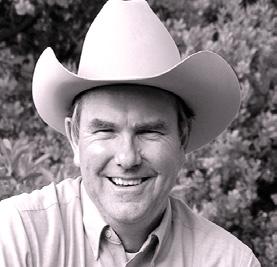
■ According to Bullard, “The U.S. sheep industry, an industry representing the economic cornerstones of rural communities across America, has been decimated. Today 74 percent of the lamb meat in the domestic market comes from foreign countries. In just the past few decades the sheep industry in America lost 62 percent of its sheep, 60 percent of its full-time sheep producers, and the packing plants that manufacture lamb are operating at an estimated one-third to one-half capacity.”
LEE PITTS
The Least Feast
In my neck of the woods every Saturday and Sunday from January through March is reserved for someone’s branding. So when it came time to brand my calves every available day was already spoken for. And no one dared jump on another rancher’s day for fear of being excommunicated. This meant that someone either had to die or quit ranching in order to claim their day. So for the first five years my wife and I had to brand our own calves which meant we worked them on a calf table. But please don’t tell anyone because this is a sin worse than jumping on someone’s branding day.
cattle they shared the range with. The sheep had greater
No, that was not the purpose of Bill’s column. It’s just that he too believes that sheep are the

USDA: Forests Converting to Carbon Emitters
BY NICK SMITH, HEALTHY FORESTS, HEALTH COMMUNITIES
Areport from the U.S. Department of Agriculture (USDA) finds American forests may convert from being carbon absorbers to significant carbon emitters. Researchers say the shift is due to the increasing destruction from natural disasters and the aging of forests, which is reducing their carbon-absorbing capabilities.
Our forests currently absorb 11 percent of U.S carbon emissions, or 150 million metric tons of carbon a year, equivalent to the combined emissions from 40 coal power plants.
However, starting in 2025, their ability to hold carbon may start plummeting and could emit up to 100 million metric tons of carbon a year as their emissions from decaying trees exceed their carbon absorption. Without action, forests could become a “substantial carbon source” by 2070, the USDA report says.
Already, several states in the Western U.S. have incrementally emitted more carbon than they removed from the atmosphere each year, including those in Colorado, Idaho, Montana, New Mexico, Utah, Arizona, Nevada, South Dakota and Wyoming – states with large amounts of federally-owned forests. Untreated insect epidemics and disease are resulting in significant tree mortality, which directly contributes to massive carbon-emitting wildfires. In Colorado, for ex-
continued on page 3
■ During the same time period we were losing six out of every ten sheep producers Bullard said, “Imports of lamb and mutton into the United States from Australia and New Zealand increased 2,363 percent in dollar value and
continued on page 2
The Green Drive to Reorganize Human Society
BY TOM DEWEESE / AMERICAN POLICY CENTER
It’s getting crazy out there. More and more of the policy proposals put out by the Green activists reveal their movement is more about forcing radical changes to our lifestyles and not about climate science or the environment. It’s like a religion where infidels must conform to their rites and rituals and heretics must be silenced.
Each day they are pushing harder and faster to implement it all. They are moving to eliminate cheap, reliable energy and gain control over our food supply, ability to travel, housing choices, available jobs, and our personal lifestyle choices. How do they expect to accomplish all of that?
Let me give you just a few of the most outrageous policies the radical Greens are promoting right now!
■ Banning gas stoves: Yep, California is already leading on this one. The excuse –“NATURAL” gas is a danger to the NATURAL environment. So homeowners, restaurants, hotels, and anyone trying to cook their food will have to surrender their gas stoves to government regulations. Pizza just might be forced into the history books!
■ Restrictions on Ice Cubes: You see, it takes energy to make ice cubes…so the drive is on to end our unsustainable use of ice cubes. Scientific American magazine says it takes a lot of water and energy to make
continued on page 4
We finally rose to number one on the waiting list and when a rancher sold out and moved to Nebraska we grabbed his day. This despite a hotly contested debate about whether the day actually belongs to a person or did it belong to the ranch? Lucky for us the new owner of the ranch wanted to raise yaks, buffalo and ostriches, which I don’t think require branding.
So we got our own branding day although it was not a very desirable one, the last Sunday in March. This meant that a rustler would have three extra months to steal our “slick” calves and by the end of March even our poorly calves would be pushing 400 pounds and no one wants to wrestle those monsters.
There has always been an informal competition amongst ranchers as to who could provide the best meal after all the calves were branded. This could get very expensive by the time the rancher filled his truck at COSTCO with beer, beans, beef and bread. There are two schools of thought, but the multi-generation ranchers believe you should spend the price of one calf on your branding dinner, while the more recent and richer ranchers say you should spend the price of two calves! There were only two exceptions: my friend Pete cheapened back by serving chicken, and myself, who believes you should spend the price of one leppy lamb.
For our first branding I took the whole crew down to the Dairy Freeze and told them they could have any-
continued on page 3
NEWSPAPER PRIORITY HANDLING
Riding Herd
by
October 15, 2023 • www.aaalivestock.com Volume 65 • No. 10
The quickest way to double your money is to fold it over and put it back in your pocket.
Saying things that need to be said.
543 percent in quantity.”
■ According to the USDA there are an estimated 5.2 million sheep in the United States. Compare that to Australia with 75 million sheep or India with 54 million sheep and you’ll see that the U.S. is a minor player on the world sheep stage.
■ Australia and New Zealand alone are responsible for 75 percent of world lamb exports.
■ Due to all the continuing problems faced by domestic sheep producers, many of which are shared by cattlemen such as concentration, imports, higher feed costs, and lower consumption, sheep no longer rank very high in importance making up less than 1 percent of the American livestock industry.
■ It’s not like lamb has fallen out of favor across the world. In other countries consumption is thriving. There are about 1.176 billion sheep in the world. China makes the biggest contribution to this figure with the largest sheep population in the world. China produces 42 percent of the global sheep population.
■ When it comes to sheep American producers are playing against a stacked deck. “For example,” says Bullard, “the poison compound 1080 is widely used in Australia and New Zealand to kill predators, but it has been all but banned in the U.S. due to environmental concerns.” Said Bullard, “We also found that the global sheep market is severely distorted by three factors: First, is because foreign imports do not have to meet America’s higher sheep produc-
tion standards. Second, the global sheep packing and processing industry is highly concentrated. And third, the much weaker value of the Australian dollar versus the U.S. dollar allows foreign imports to severely undercut the value of domestic lamb for no other reason than misaligned currency values.”
■ It’s not just the lamb market that’s sick. Before COVID, China was buying 75 percent of the world’s wool, much of it black and contaminated wool like the U.S. produces in volume because of the heavy use of the Suffolk breed. Then in 2019 China placed a 25 percent tariff on all imported wool which absolutely killed the market for American wool in China. The price for medium grade wool wouldn’t even pay for the shearing. It’s akin to the befuddled cattle feeder who was losing a hundred bucks a head but figured he’d make it up on volume.
■ There were other reasons the worldwide wool market cratered. After COVID hit, people working from home didn’t need so many nice woolen suits. And the wool industry faced the same problems other industries did: snarled supply lines, a lack of truckers, and wool warehouses worldwide were crammed full. It didn’t take long before the wool market was flooded and at a standstill.
■ One statistic more than any other explains why the sheep business is in critical condition in the U.S. Sheep producers this summer and fall experienced a downturn in meat prices of 60 percent compared to last year’s prices.
Livestock Market Digest (1SSN 0024-5208) (USPS NO. 712320) is published monthly except semi-monthly in September in Albuquerque, N.M. 87104 by Livestock Market Digest, Inc.
Periodicals Postage Paid at Albuquerque, N.M.
POSTMASTER-Send change of address to: Livestock Market Digest, P.O. Box 7458, Albuquerque, N.M. 87194
Subscribe Today
Could you take such a hit and survive?
Didn’t think so. And this didn’t happen because the sheep industry didn’t have a checkoff or COOL. They have both. The canary in the coal mine for American sheepherders may already be deader than disco. The bigger question is, is the sheep industry the canary in the coal mine for cattlemen?
Do The Math
At this point you may be asking yourself the same question Bill Bullard did. “How did this all happen?” According to Bullard, “The U.S. has historically protected its domestic sheep industry from global market distortions through the use of tariffs. These tariffs were put in place in 1890, 1921, and 1922, and then were increased under the Tariff Act of 1930. Back then, the tariffs were $3 per head for imported live sheep and seven cents per pound for lamb. But that was the last increase, meaning there haven’t been any adjustments for inflation for nearly 100 years.
“When those seemingly low tariffs were applied back then,” says Bullard, “the U.S. sheep industry flourished, supporting hospitals, Main Street businesses, places of worship, schools, and the social infrastructure of rural America.”
According to Bullard, “By 1942, while protected from global market distortions, the inventory of sheep and lambs in America reached 56 million!” Didn’t we say earlier that the inventory today is barely over 5 million head? Do the math, that equates to over a 90 percent loss in numbers!
“That’s because there’s been no adjustments for inflation, rendering those 1930 tariffs immaterial today,” says Bullard. “Consequently, and aided by global market distortions such as weaker foreign production standards, global meatpacker concentration, and a huge disparity in monetary exchange rates, the domestic lamb market
For advertising, subscription and editorial inquiries write or call: Livestock Market Digest

P.O. Box 7458 Albuquerque, N.M. 87194
Telephone: 505-243-9515
Fax: 505-349-3060 www.aaalivestock.com
EDITORIAL and ADVERTISING STAFF
CAREN COWAN Publisher
LEE PITTS Executive Editor
CHUCK STOCKS Publisher Emeritus
RANDY SUMMERS Sales
FALL MARKETING EDITION AD SALES
RANDY SUMMERS, 505-850-8544 email: rjsauctioneer@aol.com
FIELD EDITOR
DELVIN HELDERMON, 580/622-5754
1094 Koller Rd, Sulpher, OK
ADMINISTRATIVE and PRODUCTION STAFF
JESSICA DECKER Special Assistance
KRISTY HINDS Graphic Designer
has been overrun with cheaper, substandard imports.”
Bullard says, “If Congress had adjusted those 1930 tariffs for inflation, the $3 per head tariff on live sheep would be $53 per head today and the seven cents per pound on lamb meat would be $1.25 per pound!”
Falling Out Of Fashion
If sheep raisers benefitted because sheep produced both wool and meat, they also suffered greatly when both markets crashed simultaneously.
Historically, wool clothed Americans both in peacetime and in war. So important was wool that lamb and mutton were viewed as byproducts of wool production. But after World War II that formula changed as the demand for wool plunged. There weren’t near as many soldiers who needed uniforms made from wool. Prior and during the World War II the primary buyer of American wool was the U.S. military. Soldiers liked the fiber because it was flame resistant, durable, odor resistant, fast drying and breathable. But when the military downsized so did wool demand. At the same time, the increased use of synthetic fiber in clothing became fashionable.
The new synthetics were cheaper than wool and this was at a time when consumers had less money to spend. Casinos in Vegas switched from carpets made from wool to synthetic carpets even though they would later pay the price when fire struck the casino floor. One of the problems with wool was that it lasted longer in a throwaway society where women wanted to be seen constantly wearing a new outfit, not the same old woolen one. I hate to admit this, but I have Pendleton shirts in my closet that are still presentable 30 years after they were purchased. This may speak to the quality of wool, but it sure makes for a lousy marketing plan. With warehouses filled to the brim, wool marketeers had to get creative. So we now have wool being used as biodegradable fertilizer because it retains water while making better compost. But wool fertilizer will not be the savior of the American sheep industry.
Headshaking
Cattlemen who run their cattle on public lands will have a very easy time seeing that sheep are cattlemen’s canaries. The two once-opposing factions find themselves on the same side in court these days against the greenies. We could cite numerous species but what the spotted owl did for the foresters the Bighorn sheep is now doing to sheep operations in the west. Evidently the two sides, domestic sheep and wild sheep, cannot peacefully coexist. And in this divorce it’s easy to see which one gets the house.
In this case, the judge is often the BLM and the Forest Service. Both agencies and also tribal councils are having a hard time keeping the wild and the domestic sheep a safe distance
apart which is necessary due to a disease called mycoplasma Ovipneumoniae. (For now can we agree to just call it M. ovi?). It turns out that Bighorn sheep are extremely susceptible to M. ovi whose symptoms range from coughing, nasal discharge, extreme headshaking, fever, and lethargy to sudden death. Unfortunately, M. ovi has been found in the respiratory tracts of domestic sheep who don’t suffer the symptoms quite as badly as wild sheep do. And that’s the reason the two must be kept apart at all times, at least according to the greenies. That’s why state, national and tribal wildlife agencies are so intent on getting rid of the domestic sheep under their jurisdiction.
“We recognize that this disease issue poses significant challenges for wild sheep, but our research suggests that a minimum 400,000 domestic sheep, and the families who raise and care for them, may be affected by M. ovi-related impacts too,” said American Sheep Industry Association Senior Policy and Information Officer Chase Adams. “The effects are serious, not only on sheep operators and their employees, but also meat packing plants and woolen mills.”
It’s estimated that half of the domestic sheep in the west spend at least some time on public land. It bears repeating that M. ovi will do to the sheepherder what the spotted owl did to the forester. We wonder, what species will it be for the cattle?
The wild horse, maybe? The BLM and Forest Service have a plethora of likely candidates to choose from.
It’s no wonder then that the kids and grandkids of today’s sheep operators are showing such little interest in carrying on the family tradition. How fortunate for them that the greenies are excited about the prospect of buying out the woolgatherer’s grazing rights.
We hope we have made it clear that sheepmen and cattlemen share many of the same problems and for the sheepmen it may already be too late. To reverse the trends the American sheep industry needs time to work through these issues. “Congressional legislation,” says Bullard, “must be drafted that would update the 1930 tariffs and establish a permanent tariff rate quota system to effectively level the domestic sheep industry’s playing field.”
Bullard concludes, “Because they haven’t been updated, the tariffs intended to protect the domestic sheep industry against global market distortions have done nothing to prevent the U.S. sheep industry from becoming the first livestock sector in America to fall completely to competition by imports.”
One wonders, will beef be next? Needless to say, the time to work on these problems is while the canary still sings. ▫
Page 2 Livestock Market Digest October 15, 2023
NAME ADDRESS CITY STATE ZIP — MY CHECK IS ENCLOSED FOR — One Year: $25 Two Years: $35 Single copy:
Patronize Our Advertisers
$10 Clip & mail to: Livestock Market Digest, P.O. Box 7458, Albuquerque, N.M. 87194
GREEN DRIVE from page 1
thing they wanted under two bucks. Drinks and dessert were not included as I didn’t want to have to buy anyone’s root beer freeze, pistachio milkshake, vanilla cone dipped in chocolate or banana split. There were several complaints after the meal and a boycott was threatened if we didn’t up the quality of our barbecue. So for our second year we decided on something a little different... serve-yourself tacos and chips. On one table we had big containers of ground beef from a cancer eyed cow, chopped lettuce, cheese, macaroni salad slightly past its “Use By” date and a couple bags of Doritos. For portion control the wife handed out two tortillas to each adult and one for every kid. For drinks we bought an all-new garden hose.
The following year we waited and waited but no one showed up to our branding. The problem was that a gynecologist had bought a ranch in the area and brazenly jumped on our branding day. He hired a caterer to serve filet mignon steaks, five kinds of salad, corn on the cob and French bread slathered in butter. To drink there was every kind of soda imaginable along with expensive wine, local artisan draft beers and drinking water from Fiji. There were real linen tablecloths and napkins and real silverware instead of the plastic kind that always broke. The silverware selection consisted of three forks, two spoons and a sharp knife so that the ranchers didn’t have to cut their steak with the same knife they’d been castrating calves with. Dessert consisted of allyou-could eat homemade ice cream served atop apple pie or delightful berry cobbler.
There was even a place to wash up that included hot water, Lava, two types of French smelly soap and there were his and her portable bathrooms with high dollar toilet paper.
Needless to say, my wife and I were back to branding our calves on a calf table. But as a reward for my hard-working wife and to prove I wasn’t totally heartless I took her to a free gourmet mid-day-meal...over at the gynecologist’s place.

ample, the mountain pine beetle killed trees across 3.4 million acres between 1996 and 2013.
Between 2011 and 2020, Colorado faced an average 5,618 wildfires each year that burned more than 237,000 acres annually.
The report also found that our forests are rapidly aging.
Older, mature trees absorb less carbon than younger trees of the same species. Comparing forest management to prescribing the proper drugs to a patient, one researcher says one solution is cutting a small portion of aging forests to make ways for younger trees that absorb more carbon.
The best solution for reducing carbon emissions is to maintain the cycle of forestry- the continuous planting, growing and harvesting- that results in net zero carbon emissions and discourages the conversion of forests to non-forests. Yet federal agencies continue to fall behind, despite billions of dollars in new government spending on hazardous fuels reduction and other management efforts.

According to a May 2023
Congressional Research Service (CRS) report on National Forests System (NFS) lands, “Hazardous fuels can significantly affect wildfire behavior, and contribute to wildfires becoming more intense, severe, and difficult to contain.” The CRS notes that 63 million acres of NFS lands were at high or very high wildfire hazard potential in Fiscal Year 2022, yet “In the same year, the [Forest Service] reports the agency completed hazardous fuel treatments on 3.2 million acres on NFS and adjacent lands.”
This is a decrease from the 3.7 million acres reported treated in Fiscal Year 2021. According to CRS, “At this pace, it would take nearly 20 years to eliminate the backlog of treatment needs, not accounting for maintaining treated acres to the desired resource conditions. In addition, some estimate that hazardous fuels are accumulating three times faster than the rate of treatment.”
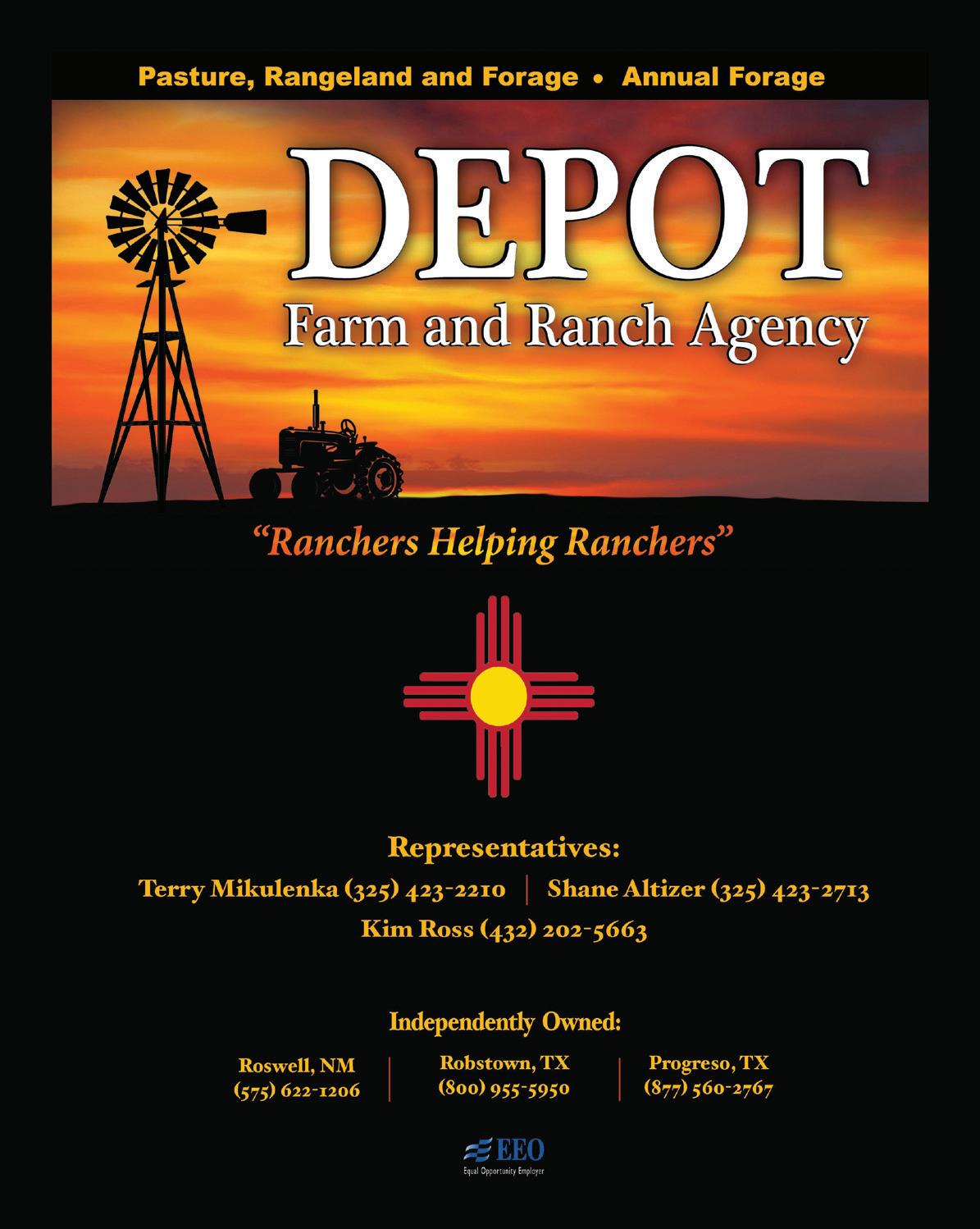
This means at least 63 million acres of the National Forest System represent a significant carbon emissions liability to the American public and U.S. government. If, or when, these

millions of acres of forests burn and die, hundreds of millions of tons of carbon will be released into the atmosphere. The Forest Service should do everything in its power to avoid this carbon emissions ticking time bomb.
It’s another reason why the Forest Service must substantially increase the pace and scale of forest management treatments to reduce fuel loads contributing to catastrophic wildfires, disease and insect infestation, and other mass forest mortality events that are emitting carbon and exacerbating climate change.
October 15, 2023 Livestock Market Digest Page 3
▫ LEAST FEAST from page 1
▫ USDA
page 1 What Is The Best Advertising Value In Western Livestock Take your marketinJ.{ program to the topf Advertise in the Contact Randy Summers ADVERTISING REPRESENTATIVE Office: 505/243-9515 Cell:
from
manhattans and margaritas. Could we do it with less ice? The time has come for “climate-friendly” cocktails!
■ Canceling fireworks: This past July 4th Los Angeles canceled several fireworks shows after a radical green NGO group filed a lawsuit claiming some fireworks displays violated the Clean Air Act by discharging plastic pollutants into the water. Isn’t it ironic that no such problem had ever been detected in over 240 previous years of Independence Day celebrations?
■ Banning short-haul airline flights: It’s much easier to control populations if you can keep everybody in place and monitor their every move. You say you just want to fly over a couple of states and visit mom? Well, not so fast. Several European nations, including France and Germany, are already banning short-haul flights under 2 hours “to cut carbon emissions.” The fact is these flight controls will have little, if any, impact on climate. In reality it’s all a fake, symbolic gesture to pretend they are fighting the “climate crisis.”
■ Blocking out the sun: This is the latest idiocy to come out of the over-active mind of Bill Gates. He says to slow global warming, we must put a layer into the atmosphere to block out the sun. There is no science to back up this scheme. And anyone who knows anything about the environment knows that every living thing on Earth needs the sun to thrive and grow. But hey – grant money drives the science!
These radical Green forces, coupled with the global powers like Klaus Schwab and his Great Reset, the Green New Deal and as I have warned for decades — Agenda 21 and Agenda 2030, are determined to reorganize human society – with them in control.
Yet, such programs are al-
ready proving unworkable and damaging to society.
For example, Biden’s “Climate Czar,” John Kerry, has been exposed as a major hypocrite as he pushes for more and more control under climate change policy. Kerry, of course, is a big promoter of such plans as the elimination of gas stoves and your favorite pizza being cooked in a wood burning oven.
But guess what! It’s now reported that in 2021, Kerry’s private jet emitted an estimated 116 metric tons of carbon in less than a year. By comparison, a wood-burning stove, such as you might use to bake a pizza, would have to bake for 849 years to equal what Kerry’s jet puts out in one year!! Of course, the elite, like John Kerry, must travel on planes to meet with fellow elites to create new dictates for you to follow. But short flights for you to meet Mom –nope! That would damage the environment!
The drive to eliminate gas-powered cars is on the front lines in the climate change battle. California has already passed laws banning the sale of them after 2035. Eighteen more states are planning to do the same. The drive is on to replace them with electric vehicles. But the electric vehicles that the auto industry is now counting on to take them into the future, are not selling! Only about seven percent of those manufactured in the last year have sold. Thousands of unsold EVs are piling up on car lots.
Electric vehicles are massively expensive. The batteries are only reliable for a few years, but then cost tens of thousands of dollars to be replaced. It takes hours to recharge them and long trips become a major hassle — not to mention the incredible damage done to the environment to mine the lithium needed to make the batteries. People don’t want EVs and they are not selling. This could be the death of the auto industry. And the incredible fact is the radical Greens see that as a positive development. After all, in their planned 15–minute smart growth cities, the goal is to eliminate cars!
And that brings us to the greatest threat of all green policies – the elimination of gas, oil, and nuclear energy sources that have fed our needs for a century.
All to be replaced by wind and solar.
Right now, across the United States, vital farmland is being covered with thousands of acres of solar panels and massive wind towers (and there’s much more to come). Nothing is damaging the environment more and doing less for human society than wind and solar power. No crops can grow under solar panels. And as they move to eliminate oil from our energy supplies, they have to have oil to manufacture the panels. And millions of trees are being destroyed to make room for the thousands of acres of solar farms.
And with thousands of acres of wind turbines, nothing will be flying in the air – endangered birds will pile up at the bottom of them. Keep in mind, to make the massive turbines turn they too need oil! Now wind towers are also being placed in our oceans where they negatively affect sea life and the fishing industry.
This is what the Greens call protecting the planet. And for all of the expense and destruction, if they manage to eliminate all other sources of power, wind and solar will provide only about 4 to 12 percent of the energy we need to run our society.
This is insanity, and it must be stopped!
The good news is they are moving way too fast – average citizens are starting to grasp the danger and feel the effects. That gives us a great leg up to build opposition to stop them.
I have recently joined forces with Committee For A Constructive Tomorrow (CFACT), a very influential force on the international and national levels. Together we are already successfully exposing these forces and slowing down their progress.
Remember when the Greens led the campaign to “Save the Whales?” They said they were so concerned about these great sea creatures and, of course, blamed human society for their demise. Well, once again, their hypocrisy is showing as the green drive for offshore wind construction spoils our coasts and threatens marine life, fishermen, boaters, and all who treasure our oceans. As the wind industry grows, more dead whales are washing ashore.
KRIRM Announces Dr. Rick Machen as Interim Director
Rick Machen was born and raised in Central Texas. He received a Bachelor of Science from Angelo State University in 1981, and pursued graduate training at Texas A&M University in College Station, receiving a Master of Science in 1984, and a Ph.D. in Animal Nutrition in 1987. Rick began his career with a beef cattle research appointment with the University of Florida Institute of Food and Agricultural Science at Ona. In 1989, he returned to Texas to pursue his passion for teaching and natural resource
CFACT president Craig Rucker just led a very successful public protest against the offshore wind towers called Save the Whales – Stop the Windmills. Craig’s CFACT protest was joined by members of the fishing industry and got huge national media coverage on Fox News and the NY Post.
Meanwhile, I have been helping to lead the fight in Iowa, South Dakota, North Dakota, Nebraska, and Minnesota to stop the idiotic Carbon Capture Pipeline that threatens thousands of acres of vital farmland and private property. I have been working with the farmers to help them stand up and resist the private corporations trying to take their property.
Recently, one of those corporations attempted to intimidate and silence farmers from speaking out. The corporation invaded Jared Bossly’s farm in South Dakota with armed guards, damaging crops and disturbing the soil. Their message to all farmers was to keep quiet, or this would happen to all of them.
The tactic completely backfired. Instead of being intimidated, the farmers stood up and took action. Hundreds of farmers converged on the South Dakota Statehouse and demanded the state legislature take action to protect their property. This is a huge win for our cause! Similar action is happening in Iowa, as the North Dakota Public Service Commission just took decisive action against development of the pipeline by denying Summit Carbon Solutions a route permit over the state.
But this is not the time for local activists to step back and congratulate themselves. Summit has already warned that this is simply a pause in their progress to enforce the pipeline.
North Dakota’s Governor and presidential candidate Doug Burgum supported Summit to use eminent domain to finish the job. South Dakota’s Governor Kristi Noem has also refused to side with the farmers, saying “It’s out of my hands… am I supposed to fight all your battles?”
It’s no wonder that many feel defeated and hopeless about stopping these forces. Sometimes it seems impossible. We
management as an Extension Specialist located in Far West Texas. In 1993, the Extension Service combined two positions, beef cattle, and goat and sheep specialists, and moved Rick and his family to Uvalde.

For almost three decades he provided leadership to regional and statewide learning opportunities such as A Gathering of Goat Producers, the Texas Beef Quality Producer Program, Texas A&M Beef Cattle Short Course, Beef Boot Camps for Retailers, the TAMU Grassfed Beef Conference and Rebuilding the Cow Herd.
In June 2016, Rick accepted a faculty position in the King Ranch® Institute for Ranch Management (KRIRM) located on the campus of Texas A&M University-Kingsville. As professor and holder of the initial Paul C. Genho Endowed Chair in Ranch Management, Rick works closely with graduate

Biden to Sign Bill Protecting Hunting,
Archery Education
BY ALAN GOTTLIEB / AMERICAN LIBERTY
Only hours after the Citizens Committee for the Right to Keep and Bear Arms (CCRKBA) blasted the Biden administration’s attempt to eliminate funding for school hunter education and archery programs, the U.S. Senate unanimously passed bipartisan legislation to prevent the cuts, and now the White House has confirmed President Biden will sign the Protecting Hunting
continued on page 5
face a dedicated, determined enemy armed with an agenda they will not back away from. But we must understand that we are not outnumbered – we are out-organized. Our Constitution and the Republic it created are not dead – they are suffering from neglect.
To stop them, freedom activists must bring the same passion and determination into fighting for our property, local business, and personal freedoms. We have made vital progress in Iowa, North Dakota and South Dakota. And I know the powerful corporations are worried. More people are starting to see the threat. Build on that and win.
students, teaches and cooperates in the development and conduct of KRIRM’s annual Holt Cat® Symposium and numerous Lectureships.
Rick and his wife Debra have two beautiful granddaughters, Evelyn and Corrie who live with their parents Sean and Mallory Dougherty in Kearney, Nebraska. Their ‘Tio Kyle’ (Machen) lives in Spring, Texas and works in the retail energy sector.
Page 4 Livestock Market Digest October 15, 2023
GREEN DRIVE from page 1
Dr. Rick Mache
▫
▫
Heritage and Education Act.
The bill passed the House 424-1 on September 28. It was championed by members of both parties who recognized the administration had deliberately misinterpreted tenets of the 2022 Bipartisan Safer Communities Act to cut funding for hunter safety, archery, and other student programs.
Joe Biden may be incapable of reading the writing on the wall, but there is no question the House and Senate members who almost unanimously passed this legislation do not suffer from the same foggy vision.
Kudos to lawmakers who acted swiftly this week to “nip this nonsense in the bud.” The administration’s attempt to cut this important funding is “one more example of the Biden administration’s extremist sentiments toward any program even remotely connected to activities that may involve the lawful use of firearms. Only one vote was cast against the House version of the bill, by a Texas Democrat.
This overwhelming action on Capitol Hill sends a clear message to the Biden White House that the administration’s anti-gun fanaticism has crossed the line when it threatens school programs that teach our children genuine safety and valuable conservation. CCRKBA is proud to have played a part in this clear victory of common sense over crass extremism.
The Senate version was introduced earlier this month by Senators John Cornyn (R-Texas), Krysten Sinema (I-Arizona), and Thom Tillis (R-North Carolina). Montana Democrat Jon Tester had introduced a separate measure. Congressman Mark Green (R-Tennessee) introduced the House version last month.
Three Chevron Deference Nightmares: What Happens When Courts Defer to Federal Agencies
BY NICOLE W.C. YEATMAN / PACIFIC LEGAL FOUNDATION
If a federal agency does something wrong to you—if bureaucrats penalize you for something you didn’t do, or cheat you out of something that should be yours—the courts should set things right. But sometimes, instead, a court will invoke Chevron Deference and defer to the federal agency.
Chevron Deference is a doctrine created by the Supreme Court’s 1984 decision in Chevron v. Natural Resources Defense Council, in which the Court said the judicial branch should defer to federal agencies’ interpretations of laws, as long as those interpretations are “based on a permissible construction of the statute.”
As Supreme Court Justice Neil Gorsuch put it, under Chevron, Rather than say what the law is, [courts] tell those who come before us to go ask a bureaucrat… We place a finger on the scales of justice in favor of the most powerful of litigants, the federal government, and against everyone else.
This isn’t an abstract legal problem. Chevron has real, harmful effects on individuals’ lives and liberty.
Here are three examples of courts invoking Chevron to defer to a federal agency, even when the agency was in the wrong.
1. The Department of Veterans Affairs cheats an Air Force veteran out of his benefits—and courts defer to the government.
While on active duty in the Air Force, Thomas Buffington suffered back and facial injuries. He also developed tinnitus, a ringing in the ears that’s often diagnosed in veterans who’ve been near explosions or loud machinery.
When Mr. Buffington was honorably discharged in 2000, the Department of Veterans Affairs (VA) assessed his injuries and awarded him disability benefits, as required by law.
But Mr. Buffington still wanted to serve his country, so he joined the Air National Guard. In 2003, his unit was called into service. This is where things get tricky: The law says that when a veteran returns to active duty and is receiving active duty pay, his disability benefits should be temporarily suspended. So when Mr. Buffington’s National Guard unit was called up, the VA stopped paying his benefits.
Mr. Buffington left active duty in 2005 and stopped receiving active duty pay. His disability benefits should have resumed immediately—but the VA never re-started payment.
In 2009, Mr. Buffington pointed out that the VA now owed him four years of unpaid disability benefits. In response, the VA insisted it would back pay only one year of benefits, citing its own rule that veterans forfeit past-due benefits if they wait more than a year before submitting a claim.
Mr. Buffington correctly argued that the law says nothing about veterans forfeiting their benefits after a year. That’s just the VA’s interpretation of
the law.
Unfortunately, the Court of Appeals for Veterans Claims and U.S. Court of Appeals for the Federal Circuit cited Chevron and deferred to the VA. Mr. Buffington lost out on three years of disability benefits he was rightfully owed.
His attorneys tried to bring the case to the Supreme Court, but the case was denied certiorari in 2022.
2. The Natural Resources Conservation Service refuses to fix its bizarre designation of a puddle as a wetland—and courts defer to the government.
The Foster family on the farm.
Arlen Foster is a third-generation farmer in South Dakota. In 1936, Arlen’s father planted trees on the south side of the family farm. Today the trees are quite tall, and most winters, they collect deep snow drifts that slowly melt until a temporary puddle collects in a low spot on the farm field.
In 2011, incredibly, the Natural Resources Conservation Service (NRCS) designated the puddle as a wetland under the Swampbuster Act.
The Swampbuster Act says that a wetland designation will “remain valid and in effect… until such time as the person affected by the certification requests review of the certification by the Secretary.”
But when Arlen requested review, the NRCS repeatedly refused. It interpreted the Swampbuster Act to mean that people could request review only if their land had been altered by a natural event, or if the NRCS itself had changed its mind about the designation. That’s not what the law says—that’s just the NRCS’s interpretation.
Unfortunately, a district court and the Eighth Circuit Court of Appeals cited Chev-

ron and deferred to the agency. Now Pacific Legal Foundation, who represents Arlen Foster, is asking the Supreme Court to hear his case.
3. The National Marine Fisheries Service forces fishermen to pay the salaries of federal observers—and courts defer to the government. Commercial fishing is a tough business with little margin for error. Each day can be a struggle to catch a profitable haul.
A 2007 law allows the National Marine Fisheries Service to put federal observers, or “monitors,” onboard commercial fishing vessels to watch fishermen and make sure they’re following regulations. For fishermen, that’s a tough-enough pill to swallow: Most commercial fishing boats are small and can fit only a limited number of people. Bringing a federal monitor onboard often means leaving one of your regular crew behind.
But here’s the kicker: The National Marine Fisheries Service was experiencing budget shortfalls and couldn’t pay for all the monitoring it wanted to do. So it decided to make fishermen pay the $700-per-day salaries of monitors watching them.
The law doesn’t say fishermen should foot the bill. That’s just the agency’s interpretation of the law. But when fishing company Loper Bright Enterprises sued the government, a district court and the U.S. Court of Appeals for the District of Columbia cited Chevron and deferred to the agency.
The Supreme Court will hear Loper Bright Enterprises v. Raimondo in its upcoming term, which begins in October. Pacific Legal Foundation is an amicus in the case.
October 15, 2023 Livestock Market Digest Page 5
▫
▫
4
BIDEN from page
How ‘Preapproved Narratives’ Corrupt Science
BY ALLYSIA FINLEY / WALL STREET JOURNAL
If experts want to know why so many Americans don’t trust “science”, they have their answer. Too many scientists no longer care about science.
Scientists were aghast last month when Patrick Brown, climate director at the Breakthrough Institute in Berkeley, Calif., acknowledged that he’d censored one of his studies to increase his odds of getting published. Credit to him for being honest about something his peers also do but are loath to admit.
In an essay for the Free Press, Mr. Brown explained that he omitted “key aspects other than climate change” from a paper on California wildfires because such details would “dilute the story that prestigious journals like Nature and its rival, Science, want to tell.” Editors of scientific journals, he wrote, “have made it abundantly clear, both by what they publish and what they reject, that they want climate papers that support certain pre approved narratives.”
Nature’s editor, Magdalena Skipper, denied that the journal has “a preferred narrative.” No doubt the editors at the New York Times and ProPublica would say the same of their own pages.
Mr. Brown’s criticisms aren’t new. In 2005 Stanford epidemiologist John Ioannidis wrote an essay titled “Why Most Published Research Findings Are False.” He contended that scientists “may be prejudiced purely because of their belief in a scientific theory or commitment to their own findings.”
“The greater the financial and other interests and prejudices in a scientific field, the less likely the research findings are to be true,” Dr. Ioannidis argued. “Many otherwise seemingly in-
dependent, university-based studies may be conducted for no other reason than to give physicians and researchers qualifications for promotion or tenure.”
In addition, many scientists use the peer-review process to suppress findings that challenge their own beliefs, which perpetuates “false dogma.” As Dr. Ioannidis explained, the more scientists there are in a field, the more competition there is to get published and the more likely they are to produce “impressive ‘positive’ results” and “extreme research claims.”
The same dynamic applies to Covid research. A July study in the Journal of the American Medical Association purported to find higher rates of excess deaths among Republican voters in Florida and Ohio after vaccines had been rolled out. Differences in partisan vaccination attitude, the study concluded, may have contributed to the “severity and trajectory of the pandemic.”
But the study lacked information on individuals’ vaccination and cause of death. It also didn’t adjust for confounding variables, such as underlying health conditions and behaviors. Charts buried in the study’s appendix showed excess deaths among older Republicans started to exceed Democrats in mid-2020—well before vaccines were available.
Despite these flaws, the study was published and pumped by left-wing journalists because it promoted their preferred narrative. The peer-review process is supposed to flag problems in studies that get submitted to journals. But as Dr. Ioannidis explained in a Sept. 22 JAMA editorial, the process is failing: “Many stakeholders try to profit from or influence the scientific literature in ways that do not necessarily serve science or en-
hance its benefits to society.” Those “stakeholders” include the scientific journals themselves, which he notes have among the highest profit margins of any industry—by some estimates, about 40%.
Journals often don’t compensate peer reviewers, which can result in perfunctory work. The bigger problem is that reviewers often disregard a study’s flaws when its conclusions reinforce their own biases. One result is that “a large share of what is published may not be replicable or is obviously false,” Dr. Ioannidis notes. “Even outright fraud may be becoming more common.”
As scientists struggle to publish against-the-grain research, many are turning to preprint servers—online academic repositories—to debunk studies in mainstream journals. Yet even some of those sites, such as the Social Science Research Network, are blocking studies that don’t fit pre approved narratives.
In January 2022, Johns Hopkins University economist Steve H. Hanke reported that Covid lockdowns had little effect on deaths. When he attempted to publish the findings on SSRN, the site turned him down. “Given the need to be cautious about posting medical content, SSRN is selective on the papers we post,” a rejection notice informed Mr. Hanke.
That’s the same response the site gave University of California, San Francisco epidemiologist Vinay Prasad when rejecting his studies debunking widely cited Covid studies, such as one claiming Boston schools’ mask mandate reduced cases. SSRN is run by the company Elsevier, which also publishes prominent medical journals that uniformly promote Covid orthodoxy. Scientific journals and preprint servers aren’t selective about research quality. They’re selective about the conclusions. If experts want to know why so many Americans don’t trust “science,” they have their answer. Too many scientists no longer care about science.
Feedlot Inventories Slowly Diminish
DERRELL S. PEEL, OKLAHOMA STATE UNIVERSITY EXTENSION LIVESTOCK MARKETING SPECIALIST
The latest USDA-NASS Cattle on Feed report pegs the September 1 feedlot inventories at 11.094 million head, down
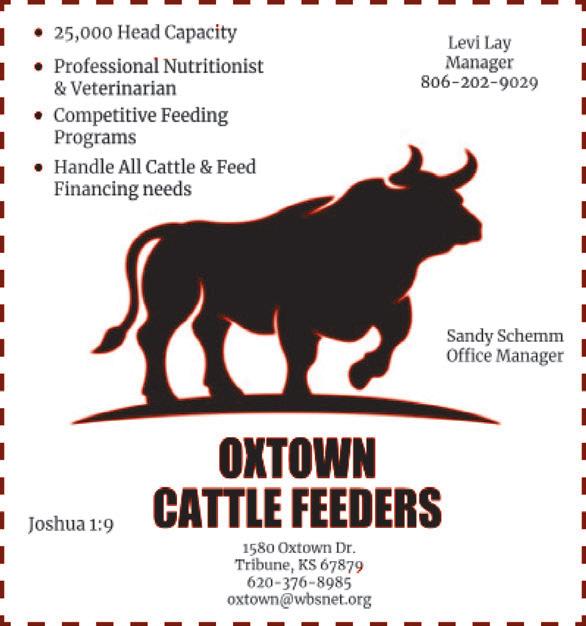
2.2 percent year over year. The September feedlot total was up slightly from the August summer low, which was the lowest monthly on-feed total since
Merck Animal Health Awards $90,000 in Scholarships to Future Bovine Veterinarians at the AABP Annual Conference
Merck Animal Health, known as MSD Animal Health outside of the United States and Canada, a division of Merck & Co., Inc., Rahway, N.J., USA (NYSE:MRK), has awarded $90,000 in scholarships to 18 bovine veterinary students in partnership with the American Association of Bovine Practitioners (AABP).
Scholarship recipients were selected based on their academic achievements, career goals, work experience and interest in veterinary medicine.
■ The scholarships were recently awarded at the 2023 AABP Annual Conference, held in Milwaukee, Wisconsin. The 2023 scholarship recipients, each receiving $5,000, include:
■ Chelsey Bieberle, Kansas State University
■ Ruth Bowman, University of Guelph
■ Caden Colombik, Washington State University
■ Bailey DeGroat, The Ohio State University
■ George DeMers, University of Pennsylvania
■ Lillian Feider, University of Wisconsin
■ Ashley Garatea, Western University of Health Sciences
■ Sonja Gilje, University of Minnesota
■ Taythen Larson, Washington State University
■ Michaela Musselman, Kansas State University
■ Ana Leigh Ruiz, Universi-
ty of Minnesota
■ Paige Schmidt, Kansas State University
■ Brooke Smith, Oregon State University
■ Alexis Stadtlander, Iowa State University
■ Vladimir Tadic, University of Calgary
■ Erica Webb, University of Georgia
■ Tanya Weber, Washington State University
■ Casey Whitehouse, Atlantic Veterinary College
“Merck Animal Health is proud to honor these veterinary students who represent the future of our field and the cattle industry,” said Justin Welsh, D.V.M., executive director of livestock technical services, Merck Animal Health. “These exemplary students embody our unconditional commitment to cattle care as well as to our mission to advance the Science of Healthier Animals®.”
“We are excited for what the future holds for these outstanding students and the talents and skills they will bring to the veterinary profession as they embark on their careers,” said Fred Gingrich II, D.V.M., executive director, AABP. “We are incredibly grateful to Merck Animal Health for its continued partnership and support for these next generation of leaders in our field.”
Founded in 1965, AABP is an international association of more than 5,000 veterinarians and veterinary students who serve as leaders in cattle health, welfare and productivity. To learn more, visit aabp.org.
September of 2019. Feedlot inventories have been lower year over year for the past twelve months.
Figure 1 shows monthly feedlot totals and a 12-month moving average, which provides a good measure of the underlying trend for the past year. The 12-month moving average peaked in September 2022 at 11.836 million head. The September 2023 12-month moving average is 11.507 million head, down 2.8 percent from the peak. Figure 1 also shows the 2014 cyclical low
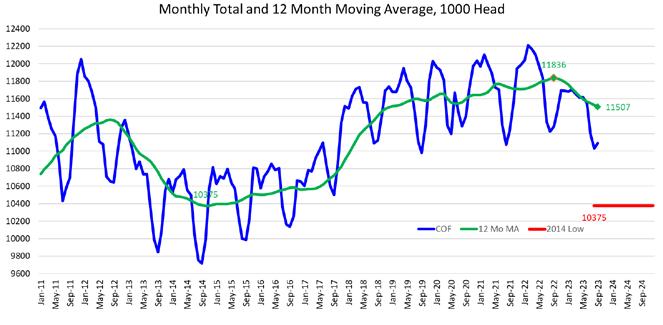
of 10.375 million head, a likely target for feedlot inventories in the coming months. Following the drought a decade ago, the 12-month moving average dropped below 11 million head in April 2013 and remained below that level for 58 months through January 2018. This was the period of rapid herd expansion in the last cattle cycle and a similar situation is likely going forward, beginning in 2024.
A line graph with the left side numbered as 12400-9600 and the bottom lined marked from Jan-11 through Sep-24. The COF is marked with a blue line, the 12 Mo MA marked with a green line and 2014 low marked
with red.
Monthly feedlot placements in August were down 5.1 percent year over year; the lowest August placements since 2019. Placements have decreased year over year for ten of the last twelve months, with total placements down 897 thousand head in the last year. A 12-month moving average of placements shows that the peak annual average monthly placements occurred in December 2019, consistent with the cyclical peak in the calf crop in 2018. However, pandemic delays from 2020 into 2021and drought enhanced placements in 2021 and 2022 have kept feedlot placements high until the last few months. The current 12-month moving average of placements for August just dropped to the lowest level since May of 2017. Average placements are expected to continue declining for the foreseeable future.
Feedlot marketings in August were down 6.0 percent year over year. Total marketings
continued on page 8
Page 6 Livestock Market Digest October 15, 2023
▫
▫
Figure 1. Cattle on Feed
of the convenience of town. Call us to take a look!
■ UNION CO., NM – 2,091.72 ac. (1,771.72 Deeded, 320 ac. -/+ State Lease), well watered w/three wells, two sets of steel pens. Well located just off of the Clayton/Springer hwy. on Barney Road.
■ UNION CO., NM – This 1,966 +/- acre ranch located just south of Clayton, New Mexico is in some of the most sought-after grazing land in the Continental U.S.A. The ranch will be excellent for a yearling operation, with high quality grass, good fences and water.

ESTATE GUIDE

■ GUADALUPE CO., NM – Enjoy ranch life on this 401.38 ac. ranch, 12 mi. W of Santa Rosa. Good location and access. One windmill, pipeline to four drinking troughs, comfortable rustic home, good fences, etc.
■ KB RANCH - Kenney Co., TX – KB Ranch is a low fenced 802 +/- acre property that is surrounded by large ranches. The ranch has abundant whitetail and is also populated with turkey, dove, quail, hogs and varmint species. Axis are in the area and have been occasionally seen. The ranch lies approximately 9 miles south of Bracketville on TX 131 and is accessed by all weather
Standart Road.
■ COLFAX COUNTY NM GETAWAY – 1,482.90 ac.+/- grassland (1,193.59 ac. +/- Deeded, 289.31 ac. State Lease), great location near all types of mountain recreation.
AG LAND LOANS

As
AG LAND LOANS AG L AND LOANS
$2,900,000
Dimmitt, TX 79027 Scott - Broker

Qualifying Broker 5:00am/10:00pm www.scottlandcompany.com
SMALL!
Guadalupe Co., deeded & 519 ranch on both flow daily)
Sumner; wildlife, buyer looking New Mexico


www buenavista-nm com
■ ANGUS, NM – 250 +/- acres with over a 1/2 mile of NM 48 frontage. Elevations from 6,800 to 7,200 feet. Two springs along a creek. Ideal for future development or build your own getaway home.
■ PECOS CO. – 637 ac., Big water, State Classified

Minerals.
TEXAS & OKLA. FARMS & RANCHES
■ CARSON CO., TX – 640 ac. +/- 5 mi. N of Panhandle on TX 207. 333 ac. +/- under 3 center pivot systems. One well produces 800 GPM. Permanent perimeter and cross fencing.
■ PALO DURO CREEK TREASURE – 941 acres +/in Randall Co. NW of Canyon, Tx. STUNNING VIEWS
• 83 acre wood home with barns, meadows and woods. Fronts State Rd. $545,000
OVER LOOKING PALO DURO CREEK. Turn key cow/calf
• 160 acre Ranger Eastland Co, $560,000
UNDER CONTRACT
■ SMITH RANCH — 19.28± section cattle ranch plus 335± acre farm located in Road Forks, N.M. The ranch has 12,343± total acres, 3721± deeded, 2400± acres of NM state land, 6222± acres of BLM, 154 AYL headquarters has mnfctrd homes, shed row barns (equipment/commodity storage), corrals, cattle chute. The north farm has 163± acres (149 +/- is fallow), the south farm has 173± acres, seller retains a “life estate”. Ranch has been in the same family since 1905. Priced at $2,300,000
Rural Properties around Portales, NM
1242 NM 480 - Nice home on 59.7 acres, grass
427 S Rrd P 1/2 - Large nice home, lots of barns 24+ ac
1694 S Rrd 4, Great home, barns, cattle pens, location
2344 S Rrd K east of Dora, NM, great - Near wind farms
All properties excellent homes & can have horses, etc.

See these and other properties at www.buenavista-nm.com
Serving all of Southern, Arizona
Land, Farms, Homes, Country Estates, Commercial National Advertising – Local Expertise
SOME OF OUR OFFERINGS
• Custom Home on 36+ acre estate in Dragoon Mountain Ranch
• 36+ acre homesites in St David, AZ
listing agent
575-825-1291
www.buenavista-nm.com
980 ac. +/past, land lays of Hwy. 54. Union Co., NM –grassland w/stateremodeled in very good pvmt. +/- heavily livestock w/ fences etc., on front gate. scenic ac. +/- on by Lincoln in Pines & covered meadow Penasco. This build a legacy ac. irr., on Mexico, adjoins
POTENTIAL
Texline Special, +/- w/water a beautiful bathrooms, metal shop.
• 270 acre Mitchell County, Texas ranch. Investors dream; excellent cash flow. Rock formation being crushed and sold; wind turbans, some minerals. Irrigation water developed, crop & cattle, modest lakes. Beautiful home, barns, and other improvements. Some minerals, game galore. All for $1.35 million.
• 80 Acre Farm land with 16” Irrigation Well in Willcox, AZ
• Custom Home on 4+ acres in Cochise, AZ
• 40 acre off grid land in Portal, AZ
United Country Real Estate | Arizona Life Homes and Land

520-403-3903 Arizonahomesandlandsales.com
Rick Frank, Designated Broker • 520-403-3903

Joe Priest Real Estate
1-800/671-4548
joepriestre.net • joepriestre@earthlink.com
NORTHERN CALIFORNIA RANCH PROPERTY 31 years in the ranch business - see www.ranch-lands.com for videos & brochures
DUANE & DIXIE McGARVA RANCH: approx. 985 acres Likely, CA. with about 600+ acre gravity flood irrigated pastures PLUS private 542 AU BLM permit. About 425 acres so of the irrigated are level to flood excellent pastures with balance good flood irrigated pastures. NO PUMPING COST! Dryland is perfect for expansion to pivot irrigated alfalfa if desired. Plus BLM permit for 540 AU is fenced into 4 fields on about 18,000 acres only 7 miles away. REDUCED ASKING PRICE - $3,125,000

BEAVER CREEK RANCH: about 82,000 acres - with 2,700 deeded acres plus contiguous USFS & BLM permits for 450 pair; 580+- acres irrigated alfalfa, pasture, and meadow from Beaver Creek water rights and one irrigation well. 3 homes, 2 hay barns, 4 feedlots each w/ 250 ton barns, 2 large reservoirs, can run up to 500-600 cows YEAR ROUND. REDUCED ASKING PRICE - $5,400,000

THE SAND CAMP RANCH is a quality desert ranch with an excellent grass cover and above average improvements. Located in southern Chaves County east of the productive Pecos River Valley. The ranch is comprised of 2,598 +/- deeded acres, 6,717 NM State Lease Acres, 23,653 Federal BLM Lease Acres and 480 acres Uncontrolled, 33,448 total acres (52.26 Sections). Grazing Capacity set by a Section 3 BLM grazing permit at 408 Animal Units Yearlong. The ranch is watered by three wells and an extensive pipeline system. This ranch is ready to go, no deferred maintenance. Price: $3,870, 000. Call or email for a brochure and an appointment to come take a look.
BEAR CREEK RANCH: Approx. 1,278 acres winter range ground and recreational property. Located on Bear Creek and accessed from South Cow Creek Valley Road. Should be great hunting for deer, wild turkey, wild pigs, quail & owner states good trout fishing in Bear Creek. Deeded access easement thru neighbor ranches.

gation, pole
CIMARRON BUSINESS, Frontage opportunity, house, big shop and office buildings, easy view off Hwy 64. Formerly known as “The Porch.” $295,000
ranch that has been owned and operated southeast of Corona, NM in Lincoln
BLM Lease Acres and 2,240 NM State AUYL. Water provided by five wells and corrals. The ranch had a good summer for a brochure or view on my website.
No improvements & very private inside the ranch.
Now only $700 per acre - $894,600
BILL WRIGHT, SHASTA LAND SERVICES, INC. 530-941-8100 • DRE# 00963490 • www.ranch-lands.com


EIGHT MILE DRAW LAND 740 ± Acres of unimproved native grassland located four miles west of Roswell in the Six Mile Hill area with frontage along U.S. Highway 70/380. This parcel is fenced on three sides and adjoins 120 acres of additional land that may be purchased. Great investment. $600 per acre.
Scott McNally, Qualifying Broker Bar M Real Estate, LLC


P.O. Box 428, Roswell, NM 88202
Office: 575-622-5867 Cell: 575-420-1237
city limits of Roswell, NM. Six total acres
Improved with a 2, 200 square foot residence, room and loafing shed. Price: $400,000 west of Roswell, NM along and adjacent
Comprised of 6,607 deeded acres and 80 acres
Website: www.ranchesnm.com
Survey available, septic’s upgraded. $475,000 MIAMI DREAM, 14.70 +/- deeded acres. Approx 1,583 sq ft 2 bedroom 1 bath home. Real country living with barn wood siding, porches, recent remodel for remote workspace. Irrigation and horse facilities, 57 Wampler St., Miami, NM $370,000 $350,000 BAR LAZY 7 RANCH, Colfax County, Moreno Valley 594.38 +/deeded acres, accessed off blacktop between Eagle Nest and Angel Fire. Historic headquarters. Currently used as summer grazing, pond and trees accessed off county road on rear of property as well. Presented “ASIS” New Survey, $4,000,000 $3,800,000
CONTRACT PENDING
SPRINGER VIEW, 29.70 +/- deeded acres. Large house being remodeled, shop, trees, old irrigation pond. All back off highway with great southern aspect. 311 Hwy 56, Colfax County. $209,000 $205,000 MAXWELL, 408.90 +/- Deeded
Acres. 143.05 Irrigable Acres/Shares with TL pivot covering approximately 80 acres, with balance dry land.


Property has one water meter used for livestock, but could support a home as well. There are two troughs located in the middle of the property. Electricity for pivot is back toward the middle of the property as well. Property has highway frontage on NM 505 and Highline Rd, a County Rd. Back up to Maxwell Wildlife area. Colfax County, NM.$599,000

October 15, 2023 Livestock Market Digest Page 7 REAL ESTATE GUIDE Livestock Market Digest CHICO CREEK RANCH, Colfax County, NM. NEW LISTING. 6,404.26 +/- Total Acres, Located approximately 10 miles east of Springer New Mexico. 3,692.60 +/- deeded acres with balance in state lease. Excellent grass and water. Two plus miles of the Chico Creek meandering through the center of the property. Additional wells and dirt tanks. Nice historic head quarters privately located with shade trees and excellent views of the property. Shipping pens in central portion of property. $2,837,318 WAGON MOUND RANCH, Mora/Harding Counties, NM. 8,880.80 +/- Total Acres, a substantial holding with good mix of grazing land and broken country off rim into Canadian River. Has modern water system located 17 miles east of Wagon Mound off pavement then 3 miles on county road. Two bedroom historic O’NEILL LAND, llc P.O. Box 145, Cimarron, NM 87714 • 575/376-2341 • Fax: 575/376-2347 land@swranches.com • www.swranches.com CIMARRON ON THE RIVER, Colfax County, NM. 7.338 +/deeded acres with 4.040 acre-feet per annum out of the Maxwell-Clutton Ditch. Custom country-chic 2,094 +/- sq ft home. Owns both sides of river in places. Horse/cow/chicken/ vegetable garden/greenhouse/orchard set up. Country living at it’s finest, in town, but in a world of your own. Very special on river. Appointment only. $650,000. RATON MILLION DOLLAR VIEW, Colfax County, NM. 97.68 +/- deeded acres in 2 parcels with excellent home, big shop, wildlife, a true million dollar view at the end of a private road. $489,000. Also listed with the house and one parcel for $375,000. MIAMI 20 ACRES, Colfax County, NM quality 2,715 sqft adobe alty er 40 ms erTY y.com SOCORRO PLAZA REALTY On the Plaza Donald Brown Qualifying Broker 505-507-2915 cell 505-838-0095 fax 116 Plaza PO Box 1903 Socorro, NM 87801 www.socorroplazarealty.com dbrown@socorroplazarealty.com COLETTA RAY Pioneer Realty 1304 Pile Street, Clovis, NM 88101 575-799-9600 Direct 575.935.9680 Office 575.935.9680 Fax coletta@plateautel.net www.clovisrealestatesales.com Selling residential, farm, ranch, commercial and relocating properties.
521 West Second St • Porta es, NM 88130 575-226-0671 or 575-226-0672 fax Buena Vista Realty Qualifying Broker: A H (Jack) Merr ck 575-760-7521
UNDER
CONTRACT
521 West Second St., Portales, NM 88130
Low As 6% OPWKCAP 6% INTEREST RATES AS LOW AS 6% Payments Scheduled on 25 Years
13830
Amarillo, TX 806/622-3482 • cell 806/674-2062 joes3@suddenlink.net Michael Perez Associates Nara Visa, NM • 575-403-7970 SCOTT MCNALLY www ranchesnm com 575/622-5867 575/420-1237 Ranch Sales & Appraisals Ba r M Real Es t a te MAJOR PRICE REDUCTION – CALL PAUL FOR DETAILS 10 Acres of commercial property, incredible highway visibility and access from either east or west directions on Hwy 60, 3 miles East of Garden Inn Truck Plaza and 4 miles west of Willow Springs. Natural gas may be available on site. LOCATION PLUS! This property is well suited for many types of businesses (Restaurant, Retail, Motel, Business of any kind!) A MUST SEE PROPERTY. MLS#11402703 See all my listings at: paulmcgilliard.murney.com Paul McGilliard, Broker Associate Residential / Farms/Ranches / Commercial 417-839-5096 or 800-743-0336 521 West Second St • Portales, NM 88130 575-226-0671 or 575-226-0672 fax 521 West Second St • Portales, NM 88130 575-226-0671 or 575-226-0672 fax Buena Vista Realty Qualifying Broker: A H (Jack) Merrick 575-760-7521 www buenavista-nm com O’NEILL LAND, llc P.O. Box 145, Cimarron, NM 87714 • 575/376-2341 • Fax: 575/376-2347 land@swranches.com
40 ACRES, Colfax County, NM. Private 2 bedroom getaway with
views, 2nd
Joe Stubblefield & Associates
Western St.,
• www.swranches.com MIAMI
elevated
guest cabin, irri-
barn great for storage. View private setting.
■ NEW LISTING! VAUGHAN RIVER RANCH –11,628.76 ac. +/- deeded - a scenic, live water ranch on the Pecos River south of Ft. Sumner, New Mexico. Excellent example of a southwestern cattle ranch with wildlife to boot all within minutes
operation w development potential. Property includes: 3/3/3 ranch style home, 4 wells, large shop plus shed, enclosed livestock working facility w/hydraulic chute, livestock pens & shed, miles of 5 & 6 barbed wire fence & over 7000’ of pipe fence. YOU WILL NOT WANT TO MISS THIS! Canyon School District. ■ DEAF SMITH CO., TX. – 651 ac. +/-, 7 miles N of Dawn, Tx., 1 mile E of FM 809. 349 acres native grass with well-maintained fencing and 302 acres of cultivated dry land. ■ PRICE REDUCED! DALLAM CO, TX – 1,216.63 ac. +/- of CRP/ranchland w/irrigation, re-development potential, wells & pipelines already in place. www.scottlandcompany.com Ben G. Scott – Broker Krystal M. Nelson – NM QB 800-933-9698 5:00 a.m./10:00 p.m. RANCH & FARM REAL ESTATE We need listings on all types of ag properties large or small!
SOLD
COLETTA RAY Pioneer Realty 1304 Pile Street, Clovis, NM 88101 575-799-9600 Direct 575.935.9680 Office 575.935.9680 Fax coletta@plateautel.net www.clovisrealestatesales.com Selling residential, farm, ranch, commercial and relocating properties. 521 West Second St Portales, NM 88130 575-226-0671 or 575-226-0672 fax Buena Vista Realty Qualifying Broker: A H (Jack) Merrick 575-760-7521 www buenavista-nm com BottariRealty Paul Bottari, Broker 775/752-3040 Nevada Farms & raNch PrOPerTY www.bottarirealty.com 521 West Second 575-226-0671 Buena A.H. (Jack) www.buenavista-nm.com or the listing agent 575-825-1291 Many good pictures on MLS or www.buenavista-nm.com A SOURCE PROVEN RED 14298 N. ELM ESCALON CONSIGNMENTS C WELCO ■ BERRENDA CREEK RANCH — 231 AYL, 51± section cattle ranch — Hillsboro, NM. 32,870± total acres, 120± deeded acres, 23,646± acres of BLM, 9104± acres of NM state land, 12 wells, 9 dirt tanks, 2 springs, 3 pastures, 195,000 gallons of water storage. Priced at $1,432,200 ■ FLYING W MOUNTAIN RANCH — 345 AYL located in the cedar mountains of Hachita, NM. 39.60± section cattle ranch, 25,347± acres total, 1278± acres of deeded land, 3152± acres of state land, 20,917 acres of BLM, four miles of newer fence, over 55,000 gallons of water storage, 17± miles of pipeline less than 20 years old, 4 wells, 4 pastures, 2 traps, 7 dirt tanks, house, barns, corrals, semi-load and livestock scales. Ranch has been in the same family since 1921. Priced at
for the year to date are down 3.4 percent. Feedlot marketings are, of course, highly correlated with slaughter. Monthly feedlot marketings are 90 percent correlated with yearling (steer plus heifer) slaughter and account for an average of 86.6 percent of monthly federally inspected steer and heifer slaughter. Marketings from small feedlots, with less than 1000 head capacity, make up the difference. Yearling slaughter for the first eight months of the year is down 3.2 percent year over year. The year over year decrease in yearling slaughter consists of a 4.9 percent year-to-date decrease in steer slaughter and a 1.1 percent yearto-date decrease in heifer slaughter.

Heifer retention is expected to increase sharply at some point in the coming months which will drop the number of heifers in feedlots and decrease heifer slaughter. The July quarterly data showed that heifers currently make up 39.9 percent of feedlot inventories. When heifer retention begins in earnest, this percent will drop to about 32 percent. This suggests that average feedlot inventories will likely drop another 1.01.2 million head at least in the next 8-18 months. Feedlot inventories will likely decline to a level close to the 2014 low in Figure 1 and stay relatively low for many months.
Derrell Peel, OSU Extension livestock marketing specialist, says the cattle market should remain strong into the fall on SunUpTV.
Co2 Pipelines: Greenwashing Subsidized Danger
SOURCE: PROTECT THE HARVEST
The American Midwest has become the epicenter in the battle against the green globalist crusade, with concerned residents fighting for their private property rights, health, and safety against three companies seeking to collectively build more than 3,600 miles of new pipeline to transport captured carbon dioxide (CO2).
Carbon capture and sequestration is unrealistically being promoted as a climate change solution, yet the truth is almost everything involved in CCS processes requires the use of fossil fuels, from the production of pipe to the fossil fuel-powered equipment used to capture CO2 and liquefy it for transport.
Currently, approximately 5,000 miles of CO2 pipeline exists in the United States. Most of these pipelines are used for a process known as enhanced oil recovery, in which CO2 is injected into oil wells to increase pressure and extract more oil. The additional proposed CO2 pipelines would be used differently, moving CO2 created by various types of manufacturing facilities including ethanol and fertilizer plants.
The CO2 would be transported to underground geologic formations that would serve as storage sites. Theoretically, this carbon capture and sequestration (CCS) technique prevents the CO2 created by manufacturing from being emitted into the atmosphere. The intent is to help slow climate warming patterns attributed to greenhouse gas (GHG).
However, CO2 pipelines come with potential danger from breaks or leaks. Additionally, the alleged environmental benefits and efficacy of CO2 transport and storage are questionable at best. Regarding their opposition to the proposed pipelines, concerned citizens and anti-pipeline groups find themselves on the same side of this debate as environmental extremist organizations.
The three companies attempting to construct CO2 pipelines in the Midwest are Summit Carbon Solutions, Navigator CO2, and Wolf Carbon Solutions. Combined, the proj-
ects would transport 39 million tons of captured carbon annually to be stored underground in North Dakota and Illinois. Other states that would be affected by the currently proposed pipelines corridors include Iowa, Nebraska, South Dakota, and Minnesota.
North and South Dakota have already denied permits to the companies, effectively granting a reprieve for concerned landowners in all states involved. Nevertheless, the overall threat remains as the companies look for alternatives, and green energy investors seek to build more CO2 pipelines in the future, ignoring citizens’ property rights and safety concerns.
Taxpayer-Funded “Pump and Dump” Scheme
Some projections estimate more than 60,000 additional pipeline miles need to be constructed to meet climate-related United Nations (UN) goals embraced by the Biden administration. In 2021, the UN’s Intergovernmental Panel on Climate Change (IPCC) reported that merely reducing CO2 emissions was insufficient, and nations must also capture and store CO2.
Hence, the mad dash to build CO2 pipelines has been fostered by federal government incentives to construct so-called green infrastructure, with billions of dollars up for grabs in the form of subsidies and tax credits. The availability of taxpayer dollars for pipelines started in 2008 with the 45Q tax credits, which was followed by the Utilizing Significant Emissions with Innovative Technologies (USE IT) Act of 2020 which pays $50-per-ton. Ironically, the recent so-called “Inflation Reduction Act” signed by Joe Biden upped the incentive to $85-per-ton.
In early May 2023, the Department of Energy announced $251 million to support the development of CCS infrastructure, and the second opening of a five-year, $2.25-billion, funding opportunity. In total, the Inflation Reduction Act has created up to $369 billion in “climate and energy” funding.
Blatant Abuse of Eminent Domain
Eminent domain is the process through which private property can be confiscated for public use or the “public good.” Originally reserved for use by the government for the development of infrastructure and utilities, the ability for private companies to invoke eminent domain was established in 2005 by the U.S. Supreme Court case, Kelo v. City of New London. In a devastating blow to private property rights, the court ruled lands could be seized for commercial development based on the possibility of increased tax revenue or jobs.
Prior to the pipeline permits being denied in South Dakota, more than 80 landowners in the state had been served with eminent domain actions to seize their lands. Additionally, the landowners have been dealing with an onslaught of harassment, blatant trespassing, and crop damage by surveyors who prematurely sought to mark pipeline easements long before the permitting process was completed.
Such contemptuous disregard for due process and private property rights is arrogant and appalling. More worrisome is the possibility that such disregard for property rights may foreshadow behavior endorsed by the “Great Reset” agenda of the UN and World Economic Forum (WEF). States handle eminent domain differently, so it is vital for landowners to be familiar with their state and local laws, develop relationships with lawmakers, and understand their private property rights.
Physical Safety of People, Livestock, and Wildlife at Risk
CO2 pipelines can be extremely dangerous. CO2 can exist as a gas, a liquid, or as dry ice. For CO2 to be moved via a pipeline, it must be liquefied under pressure that’s three times the rate of natural gas shipped in pipelines.
Made of carbon steel, CO2 pipes measure from 4 to 24 inches in diameter with operating pressures of as much as 2,200 pounds per square inch. The immense pressure itself can be deadly at close range in the event of a leak or rupture, but more concerning is that the contents of the pipelines can be fatal to humans, livestock, and wildlife, depending on their proximity to a leak and the length of exposure. A CO2 pipeline rupture can create a toxic plume that can rapidly spread a mile or more. In high enough concentrations, CO2 could cause death within minutes.
In February 2020, a CO2 pipeline used for enhanced oil extraction near Sartartia, Mississippi, ruptured. Three hundred people were evacuated, and 45 required emergency medical care. Because internal combustion engines require oxygen to operate, the leaking CO2 caused cars to stop working, greatly hindering emergency response.
CO2 poisoning can cause lingering health effects lasting months or years. Some Sartartia residents are still dealing with health issues stemming from the pipeline rupture.
With similar contempt for what Hillary Clinton once famously referred to as “flyover country,” pipeline executives refused to release their companies’ plume studies that outline risks, claiming such information could be utilized for nefarious purposes. Navigator CO2 vice-president of government and public affairs, Elizabeth Burns-Thompson, publicly stated that the complexity of the data and work was simply beyond the general public’s ability
to understand.
However, an independent carbon dioxide study showed that, depending on pipe diameter, pressure, and distance between shut-off valves, a pipeline rupture would cause immediate death within a certain radius, with engine failure and “human function decline” within respectively increasing radiuses.
In fact, insurance companies have mailed policy holders letters stating that they would not offer liability coverage to landowners with a pipeline running beneath their property. Navigator CO2 is nevertheless pressing ahead in its effort to build its pipeline. If the pipeline is completed, approximately $1.3 billion in federal tax credits would be given to the company.
CO2 Is Necessary for Life on Earth
While concentrated carbon dioxide can be dangerous for humans and animals, it is a vital component of our atmosphere and literally makes life on Earth possible. According to NASA, the air we breathe is 78 percent nitrogen, 21 percent oxygen, and one percent other gases, including carbon dioxide. Carbon dioxide is normally about .04 percent of the total. Green plants absorb CO2 during photosynthesis, converting it, and water (H2O), into oxygen and food. Without CO2, our carbon-based life form could not exist. Anyone who has traveled through the U.S. knows about the abundance of green trees in America.
The rising level of atmospheric CO2 is not the environmental bogey-man environmental zealots and companies that benefit from a green agenda make it out to be. In fact, a slight increase in CO2 has helped enable the greening of the Earth, with a 5 percent increase in global green leaf area in the last two decades. This increase comprises an area equivalent to the size of the entire Amazon rainforest.
The environmental extremist crowd, and “green” companies looking to profit from CCS, attribute climate change to increases in atmospheric CO2. Their rhetoric also points to those increases being human-caused. However, some research indicates that CO2 levels rise naturally as a result of warming.
You can Help by Being Informed, Engaged, and Involved

It is more important than ever that people educate themselves about private property rights and the realities of the green, globalist agenda. It is also vital for people to become familiar with political candidates and where they stand on environmental issues, and then vote accordingly. The truth can only prevail through the engagement and involvement of a properly informed citizenry. The future of A Free and Fed America depends on we the people doing the right things.
Editor’s Note: It is worth noting that New Mexico and other states are now looking at these pipelines as they pursue “clean energy.” ▫
Page 8 Livestock Market Digest October 15, 2023
▫ Patronize Our Advertisers FEEDLOT from page 7
Proposed Amendments to the Horse Protection Act Can Make Every Horse Owner a Criminal
SOURCE: WESTERN JUSTICE
On August 21, 2023, the USDA’s Animal and Plant Health Inspection Service released a proposed rule change to amend the Horse Protection Act (HPA). To protect the industry and to keep animal
extremist ideologues with no experience in equine animal husbandry from controlling our every move, all horse owners must pay attention to the proposed new language and participate during the comment period.
Comments are due on October 20. Visit https://www.
Gordon Rejects $5 Million From Biden To Shut Down Oil Wells
BY LEO WOLFSON / COWBOY STATE DAILY
Gov. Mark Gordon doesn’t want any part of President Joe Biden’s plan to reduce carbon dioxide emissions by curtailing oil production.
Gordon announced in early October he will reject $5 million from the Biden administration earmarked to shut down low-volume oil wells, often referred to as stripper wells.
The administration is using federal Inflation Reduction Act money to provide incentives to states to shut down certain oil wells.
According to the Environmental Protection Agency, the Inflation Reduction Act provides new avenues to reduce methane emissions from the petroleum and natural gas sector through a Methane Emissions Reduction Program. The program offers $350 million to states under the umbrella of reducing methane emissions.
A stripper well is defined as producing a maximum daily average of no more than 15 barrels of oil per day or no more than 90,000 cubic feet of natural gas per day during any 12 consecutive months. According to the governor’s office, stripper wells provide about 10 percent of the state’s oil production and generate about $265 million annual revenue to Wyoming.
According to the National Stripper Well Association, stripper wells make up more than 7.4 percent of U.S. oil production. They also produce less than 90 thousand cubic feet a day, yet account for 8.2 percent of U.S. natural gas production.
“This approach – concocted by D.C. bureaucrats – shows a complete disregard for the importance of this industry to Wyoming’s economy,” Gordon said in the press release. “These are wells that have, and will continue to produce, significant amounts of oil; provide jobs through hundreds of small businesses; and generate revenues for schools, the state and local government.”

Plugging The Problem
Gordon said even without the funding, Wyoming still leads the nation in plugging abandoned and orphan wells.
As of 2014, Wyoming had about 1,200 abandoned wells, reported High Country News. ▫
federalregister.gov/documents/ 2023/08/21/2023-17814/ horse-protection to get details on how to comment.
Laws Protecting Horses Have Been In Place for Decades but Animal Extremist Groups Want to Make Owning and Exhibiting Horses Difficult
The Horse Protection Act has been in place for decades. Its original intention was to regulate practices found primarily in the Tennessee Walking Horse industry. Despite the language in the Horse Protection Act making the soring of Tennessee Walking horses illegal, animal extremist groups have been vying to expand their reach to encompass the entire horse industry for years.
They aim to use the Horse Protection Act to insert their animal extremist ideology by changing the verbiage. Groups like the HSUS and PETA and supposed equine advocates such as the American Horse Council and the American Association of Equine Practitioners are behind these numerous attempts to push the verbiage change. For those still in denial about the HSUS and other animal rights organizations’ involvement in working to destroy the horse industry, it is noted in the document that the HSUS filed a lawsuit over the HPA in 2019. The document states, “On August 13, 2019, the Humane Society of the United States and other nongovernmental organizations filed a lawsuit. HSUS argued that the 2017 HPA final rule had been duly promulgated and could not be withdrawn without first providing public notice in the Federal Register and an opportunity for public comment. On July 27, 2020,
the U.S. District Court for the District of Columbia dismissed the suit, holding that a rule becomes final upon publication in the Federal Register.”
Requirements Listed in HPA Which Will Now Be Expanded to All Horse Breeds
In addition to the broad-sweeping definitions, the current HPA, primarily applied to Tennessee Walking Horses, will now be applied to all horse breeds. The document states “These requirements allow APHIS to establish a broader record of events covered under the Act, allowing for adjustments to enforcement should noncompliance with the Act become an issue in current or emerging horse breeds.”
The HPA document is 129 pages long, and we encourage horse owners to read it thoroughly. In reference to space, we will bullet point and summarize some of the egregious and overreaching regulations that all horse owners and organizers who participate in shows, exhibitions, and sales will be subject to:
■ The prohibition of any equipment, practice, or method that could make a horse sore, lame, or irritated.
■ The prohibition of any application of substance that could make a horse sore or have an inflammatory reaction.
■ Prohibition of any use of substances on the limbs; this includes skin and hair conditioners, fly spray, or anything else that could diminish the signs of soring.
■ Persons subject to liability
are “participants,” which include the following activities: direct participant, agent, transporter, instructor, coach, trainer, vendors, supporters, and sponsors.
■ Mandatory rest periods during shows, exhibitions, sales, and auctions.
■ Providing any and all information requested on demand.
■ Application of new language which essentially requires a horse’s legs to be free from any blemishes. “ The forelimbs and hindlimbs of the horse must be free of dermatologic conditions that are indicative of soring. Examples of such dermatologic conditions include, but are not limited to, irritation, moisture, edema, swelling, redness, epidermal thickening, loss of hair (patchy or diffuse) or other evidence of inflammation. Any horse found to have one or more of the dermatologic conditions set forth herein shall be presumed to be ‘sore’”.
■ Inspection and detention of horses. Such inspection, “may include, but is not limited to, visual inspection of a horse and review of records, physical examination of a horse, including touching, rubbing, palpating, and observation of vital signs, and the use of any diagnostic device or instrument, and may require the removal of any shoe or any other equipment, substance, or paraphernalia from the horse when deemed necessary by the professional conducting such inspection.”
continued on page 11
October 15, 2023 Livestock Market Digest Page 9
Lummis Accuses Biden of Favoring Blue New Mexico Over Red States in Energy Policies
BY BREANNE DEPPISCH, ENERGY AND ENVIRONMENT REPORTER, THE WASHINGTON EXAMINER
US Senator Cynthia Lummis (R-WY) is accusing the Biden administration of politicizing new public lands protections, accusing it of prioritizing oil and gas production in Democratic-led New Mexico while curtailing oil and gas production in Wyoming, Alaska, and other conservative states.
In an interview with the Washington Examiner, Lummis, the chairwoman of the Senate Western Caucus, noted that New Mexico is now outproducing her state of Wyoming in the areas of both natural gas, with 8.4 billion cubic feet per day
versus 3.3 billion, and oil, with 1.76 million barrels per day versus 265,000.
Since the two states are both home to massive proven oil and gas reserves, Lummis asserted that politics is likely a primary driver behind the disparity, which she says benefits Interior Secretary Deb Haaland’s home state of New Mexico, where Democrats control the governor’s office and the legislature, while harming Republican-led states such as Alaska and Wyoming.
“We’re really frustrated with the Biden administration’s crackdown in Wyoming and Alaska on oil and gas production — and letting it flow freely in New Mexico, which is where Deb Haaland is from,” Lummis

said.
Lummis also took aim at the Interior Department’s new ban on oil and gas drilling in Alaska’s North Slope and cancellation of seven oil and gas leases issued in Alaska, announced earlier this month as part of the Biden administration’s push to expand federal land protections.
The Bureau of Land Management’s Rock Springs Field Office Draft Resource Management Plan announced in August would designate 1.8 million acres of land in Wyoming as Areas of Critical Environmental Concern, making the areas off-limits for oil and gas development.
Combined, the moves are “a massive punch to the gut” for Wyoming and Alaska, Lummis told the Washington Examiner
“And it just shows how much contempt they really have for conservative states and how disingenuous they are by turning back on the oil and gas development that’s going on in New Mexico — and continues to grow — while trying to impair Alaska and Wyoming in their ability to produce oil and gas,” she said.

It’s not the first time that President Joe Biden’s actions have incurred the wrath of Republicans in red states over its efforts to curb climate change and reduce carbon emissions from fossil fuels. At the same time, the administration has faced criticism from environmental groups for the steps it has taken to encourage domestic production, especially to improve energy security following Russia’s invasion of Ukraine.
Environmental groups were outraged after the Biden administration approved the Willow Project, or ConocoPhillips’s
The 7 Up Ranch Cookbook

The Story of Arizona’s Historic 7 Up Ranch with Recipes and Photos


For more than five decades, award-winning journalist and photographer Kathy McCraine has been documenting ranch life in the American West. For the past 25 years she has called the sprawling 7 Up Ranch in the mountains of northern Arizona home. In her new book, The 7 Up Ranch Cookbook, she combines her love of cooking with her love for ranching in a tribute to the traditional cowboy way of life.
The 7 Up Ranch Cookbook: The Story of Arizona‘.s Historic 7 Up Ranch with Recipes and Photos is equal parts cookbook, history lesson and photographic essay. The collection contains over 100 recipes from the many families and friends who have been associated with the ranch over the years, blending sophisticated techniques and ingredients with plain old, hearty, down home, ranch cooking. All seasoned throughout with anecdotes and tales from life on the range, and rich photography that captures the breathtaking beauty of th e
massive, 600 million barrel drilling project in Alaska, in March.
Groups such as the Center for Biological Diversity, Earthjustice, and the Sierra Club all castigated the administration’s decision and vowed to stop the Willow Project from moving forward.
But Republican-led states, especially in the West, have been equally irate.
Lummis also took issue with the Bureau of Land Management’s proposed Public Lands Rule, which would allow the agency to lease federal lands for conservation purposes.
This would change an existing law created by Congress in 1976 to govern federal land use and would give groups opposed to new fossil fuel development the same right to bid on federal leases as oil companies, miners, and cattle ranchers — possibly stifling resource production.
Biden’s actions have been “one step forward, two steps back,” Lummis said. “He’s trying to placate global warming activists with his rhetoric. And then he has to follow through at some point because if he doesn’t, they know he’s insincere on that.”
While BLM contended the proposed rule would allow it to better uphold its duty to manage federal lands and deliver on its duty to prevent “unnecessary or undue degradation,” a group of state attorneys general led by Montana alleged in letters to BLM this summer that it is a “flagrant violation” of federal law and threatens “substantial harm” to their respective economies. Montana Attorney General Austin Knudsen told the Washington Examiner this summer that he plans to challenge it in court.
The administration “is in a position to use their executive branch whip to curtail availability of oil and gas leases in Alaska, Wyoming, and hide behind the fact that we have more federal land,” Lummis said. “So they can argue that New Mexico’s development is primarily on state and private land.”
The Biden administration did not respond to the Washington Examiner’s request for comment.
Senator Dan Sullivan (RAK) and Representative Harriet Hageman (R-WY) introduced legislation earlier this month that would require federal agencies to show how their new regulations and proposed energy projects would affect costs for communities at risk of energy poverty, including in Alaska and other Western states.
Lummis did not say at the time whether she planned to support the bill, though she described it as a “worthy goal.” ▫
ranch and the traditional day to day work of its cowboys and families.
The 7 Up Ranch is a traditional working cattle ranch, its roots tracing back to the 1880s when Arizona’s ranching industry was in its infancy. The history of the 7 Up will introduce you to such fascinating characters as John Lovelace, a notorious cattle rustler who lived deep in Burro Creek Canyon; Harry Knight, who performed in Buffalo Bill’s Wild West Show and turned part of the ranch into Arizona’s first dude ranch; and Bertha Schell, a lady miner who prospected for gem stones in the rug-
ged canyons of the 7 Up and shared a tumbledown shack with her herd of goats.
The 7 Up Ranch Cookbook has something for everyone: ranch history, cowboy tales, beautiful photography, and mouth watering recipes. It’s a one-of-a-kind book that belongs on the shelf of every cookbook collector and every student of Western culture and history. The 180-page, hardback, full color book is available at www. kathymccraine.com for $34.95 plus $6 shipping.
Page 10 Livestock Market Digest October 15, 2023 Kaddatz Auctioneering & Farm Equipment Sales New & Used parts, Tractor & Farm Equipment. Salvage yard: Tractors, Combines, Hay & Farm Equipment Online auctions: We can sell your farm, ranch & construction equipment, surplus vehicles & equipment anywhere in the US. 254-221-6120 We have a 15% rebate on new parts ordered online – farmstore.online www.kaddatzequipment.com Bradley 3 Ranch Ltd. www.bradley3ranch.com M.L. Bradley, 806/888-1062 Cell: 940/585-6471 Ranch-Raised ANGUS Bulls for Ranchers Since 1955 Annual Bull Sale February 10, 2024 at the Ranch NE of Estelline, TX Take your marketinJ.{ program to the
Advertise in the Contact Randy Summers ADVERTISING REPRESENTATIVE Office: 505/243-9515 Cell: 505/850-8544 rjsauctioneer@aol.com
topf
▫
BLM Says It’s Misunderstood, Claims No Plans to Lock Public Out of 1.8 Million Acres
BY MARK HEINZ / COWBOY STATE DAILY
The Bureau of Land Management (BLM) isn’t planning to lock out Wyoming’s public from the Rock Springs area, agency officials told Cowboy State Daily.
“The most frustrating thing for us is all of the misinformation out there. We’re not closing any areas to all hunters or people walking their dogs or some of the other nonsense that has been out there,” said Kimberlee Foster, field manager for the BLM’s Rock Springs office.
Moreover, the BLM wants to hear from the public during an open comment period for the draft Rock Springs Resource Management Plan (RMP), said Brad Purdy, the BLM’s deputy state director of communications. In fact, the comment period is probably the most vital part of the process.
The draft proposal, maps and other information are available online, as is a guide for filing comments.
Plan Has Drawn Fire
The Rock Springs BLM field office oversees roughly 3.6 million acres in Wyoming. The draft RMP designates 1.8 million acres of that as “areas of critical environmental concern” (ACES).
Gov. Mark Gordon and other Wyoming elected officials have harshly criticized the draft Rock Springs RMP since it was released last month.
Most recently, it also drew fire from members of the Wyoming Legislature during a virtual town hall meeting hosted by the Wyoming Freedom Caucus. And Wyoming Republican U.S. Rep. Harriett Hageman also blasted BLM officials during recent congressional hearings.
Hagman and the legislators claimed the RMP could end up essentially locking out hunters, ranchers, energy development and the public at large.
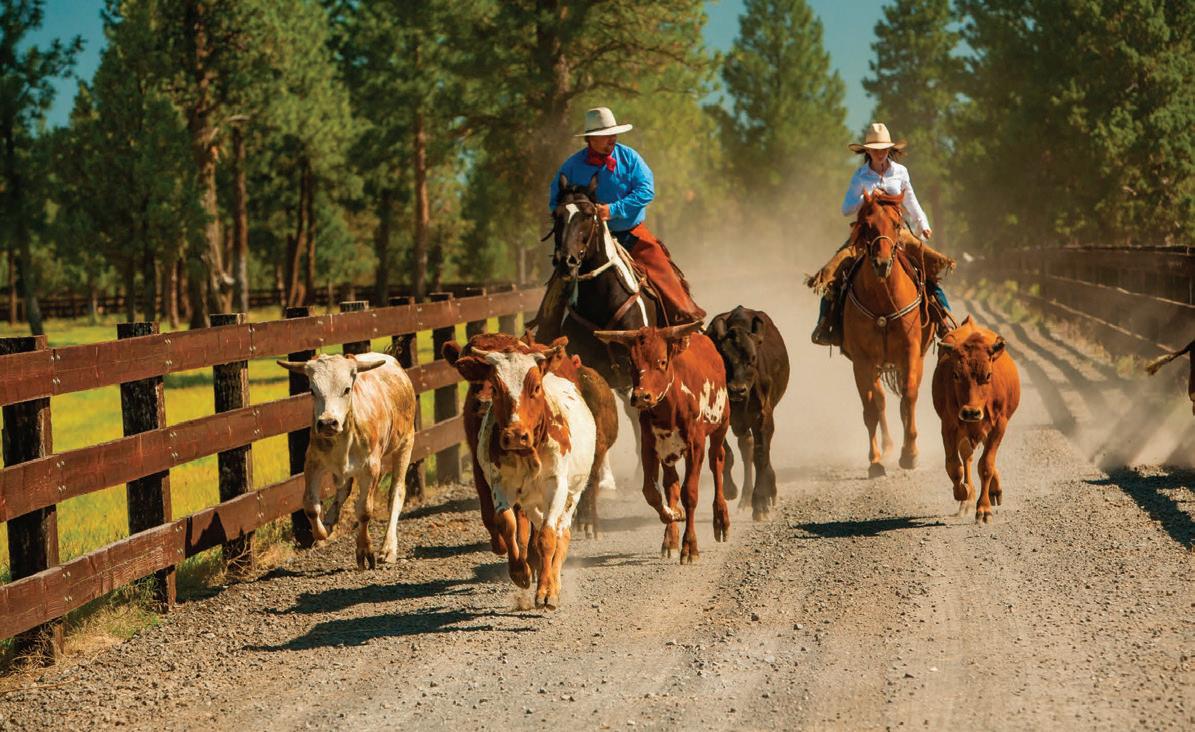
BLM Wants To Hear From Wyoming
Despite the criticism, the BLM is eager to hear from Wyomingites, Purdy said. Public comments will play a huge role in finalizing the plan. Currently, there are four draft options, and the BLM prefers “alternative B,” but substantive comments could steer things in another direction.
What the agency needs is well-argued, factual comments, Purdy said.
“It’s not a popularity contest, that’s not what we’re looking for. We need to hear why. The ‘why’ is extremely important,” he said.
The BLM values feedback from people who regularly work, hunt, recreate or explore the lands in question, he added. Those people might be able to point out things the agency missed.
Could Comment Period Be Extended?

The comment period is set to close Nov. 16, and there’s a chance it could be extended.
The co-chairs of the Wyoming Legislature’s Joint Agriculture, State and Public Lands and Water Resources Committee sent a letter to BLM Director Tracy Stone-Manning requesting that the public comment period on the proposal extend to at least March 2024. The letter was signed by State Senators Cheri Steinmetz, R-Lingle, and Rep. Barry Crago, R-Buffalo, and sent to Stone-Manning on September 19.
Whether the comment period will be extended hadn’t been decided as of Monday, Purdy said.
“We’re working to get a final decision on that,” he said. “I have not heard of any action one way or the other.”
Once the comment period closes, the BLM will go through all the input and decide whether the draft plan needs to be changed or clarified accordingly, Foster said. That process could
take months. The BLM will then release its final environmental impact statement regarding the Rock Springs RMP, after which people will be given a 60-day period to file protests. Then the BLM will enter its final record of decision, she said.
At the earliest, the entire process could take until next spring, Foster said.
Road Closures?
One common criticism is that the plan as drafted could end up closing numerous roads or otherwise restrict motorized use across vast areas, Foster said.
But that’s not true, she added.
There are no current plans to close most existing motorized roads and trails, although the existing rule that vehicles must stay on those designated routes will stay intact, she said.
The only possible motorized closures would be in the immediate vicinity of particular landmarks or historical sites, such as Boars Tusk or the Cedar Mountain Petroglyphs, Foster said.
Under the BLM’s preferred alternative, the Killpecker Sand Dunes area in Sweetwater County would remain a “free play” area for off-road vehicles, she added. That means people could continue to drive or ride off established roads and trails there.
Riparian Zones Protected
During the virtual town hall meeting, State Representative Allen Slagle, R-Newcastle, said he was concerned that the BLM’s preferred alternative would lock ranchers out under the auspices of protecting riparian zones from overgrazing. Riparian zones are areas of lush vegetation along the banks of streams and creeks.

Foster said the BLM has no plans to simply push cattle out of all riparian zones. Instead, moving forward the agency might consider specific riparian zones that were “severely degraded” on a case-by-case basis.
In some cases, the agency might temporarily close those places for replanting or other recovery efforts, she said.
■ Horses can be detained by “Horse Protection Inspectors” for 24 hours.
■ Show and event management must provide ample space on grounds for inspections and detentions to take place.

■ Testing and evaluating horses at horse exhibitions, horse shows, sales, or auctions by newly hired APHIS personnel given the title “Horse Protection Inspectors.”
■ Allow free and uninhibited access of APHIS inspectors to records, barns, compounds, horse trailers and vans, stables, stalls, paddocks, and all other show or exhibition grounds.
■ Warm-up areas must be policed.
■ Identity of each horse entered at a show, exhibition, sale, or auction must be verified.
■ All horse show and exhibition records must be maintained for 90 days. Data collected ranges from judges’ score sheets to owner and sponsor information and more. Copies of all records must be made available to “Horse Protection Inspectors.”
■ Records must be collected and maintained for horses receiving therapeutic care, i.e., pads, special shoes, or other medications. Complete veterinary medical information must be collected, including the entire diagnosis and treatment plan as well as the cessation of date of treatment, the state license number of the veterinarian, and much more.
■ Notifying APHIS 30 business days in advance of events and 15 business days in advance of any changes to the event.

■ If a “Horse Protection Inspector” is unavailable on the show dates, a variance must be requested within 15 days of the start of the horse show.
■ Management of any horse show, exhibition, sale, or auction that does NOT include Tennessee Walking horses must report to the APHIS regional director of the state within five days of any horse that was disqualified from being exhibited or sold because it was found to be sore.

■ Requiring a quarterly and yearly report to APHIS of all horses and owners within an organization who have been disqualified at any show, exhibition, sale, or auction.
■ Requirements for shipping and transporting horses.
■ Subject to lameness examinations before showing, exhibiting, or entering a sale, including evaluating the horse’s movement, posture, and palpation of the limbs to detect local pain and inflammation.
■ Any horse winning first place in a class is required to be re-inspected.
■ Horses that receive a rub or blemish while in the ring competing are subject to HPA violations.
■ Prohibitions regarding holding horses for inspection –horses’ reins cannot be held any closer than 18” away from the bit, nor can the bit be pulled on during an inspection.
■ Prohibition of any device, method, practice, or substance that hides or masks a sore horse. ▫
October 15, 2023 Livestock Market Digest Page 11
▫
lit Yes. Please subscribe me to the Livestock Market Digest for: □ 1 Year at $25 □ 2 Years at $35 NAME ADDRESS CITY STATE ZIP PHONE E-MAIL 0 MC O VISA CARD NUMBER EXPIRATION DATE CC# CCV# SIGNATURE □ Payment Enclosed
HORSE PROTECTION ACT from page 7












































